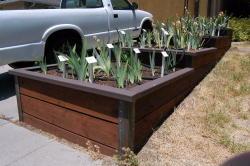Planting what you just amended is good for several reasons. The cover crop will compete with weeds and suppress some of them.
The cover crop roots will continue to break up your clay without you swinging a pick and raking out clods.
The cover crop roots will help maintain open soil structure after the compost is digested and the clay tries to revert to airless, rock-hard clay.
When they die and decay, the cover crop roots and tops will add more organic matter to the soil than you bought and hauled in bags.
The cover crop roots will prevent erosion from rain and wind.
The cover crop tops will shade the soil.
That said, I usually forget to, or I;'m too lazy to, plant cover crops. usually I try to go straight to growing vegetables or flowers. I need to listen to Dave's podcast, something like "Why don't we do what we KNOW we should do?"
My theoretical compromise between what most people agree on and what I seem to have found necessary in my yard, would be to scratch up just the top few inches and mix with an affordable amount of compost and bark, but not go deep and not screen the clay balls laboriously through 1/4" screen. Hopefully that would create enough aerated "almost-soil" for hardy roots to grab hold and let the plants survive long enough to drill down into the clay over a few years. Plant cover crops for the first two years! Then try digging down 12-18" and see how much the solid clay has improved.
There are cover crops that tolerate heavy clay soil and no drainage. Here are some notes I took once. The short form would be: clover, oats, rye, vetch, alfalfa, Buckwheat and some cowpeas.
Actually, the best choice is whatever your local fed store stocks in big bags and is recommended LOCALLY for breaking up clay. Stress that it is not "clay soil" already in cultivation that you want to improve. If it is really bad, it is "clay" that you want to convert to arable "soil".
Annuals that tolerate and loosen heavy soils, cool weather:
Austrian Winter Pea
Barley, Awnless
Barley, Bearded
Bell Bean
Clover, Alsike
Clover, Berseem
Clover, Hykon Rose
Clover, Nitro Persian
Clover, Subterranean Mix
Clover, Sweet-Biennial Yellow
Daikon Radiash (??)
Legume / Oat Mixes
some Mustards
Oats, California Red
Oats, Cayuse White
Oats, Montezuma Red
Oregon Annual Ryegrass
Rye, Cereal
Rye, Merced
Tetraploid Annual Ryegrass
Triticale, Trios
Vetch, Common
Vetch, Hairy
Vetch, Lana Woolypod
Vetch, Namoi Woolypod
Vetch, Purple
Zorro Fescue
Perennials that Tolerate and loosen heavy soils:
Alfalfa [P]
Clover, Strawberry [P]
Clover, White [P]
Creeping Red Fescue [P]
Ryegrass, Perennial [P]
Sheep Fescue (Covar) [P]
Timothy Grass [P]
warm weather + heavy soil:
Buckwheat
Cowpea, Red 50
Crotolaria
Lablab
Sesame
Sesbania
Soybean
tolerates poor drainage:
Wheat, Red Winter
Clover, Alsike
Clover, Berseem
Clover, Nitro Persian
Clover, Sweet-Biennial Yellow
Miranda Pea
Rape, Canola
Rye, Cereal
Rye, Merced
